小学英语绘本故事阅读活动方案word版本
英语绘本阅读教学活动方案设计
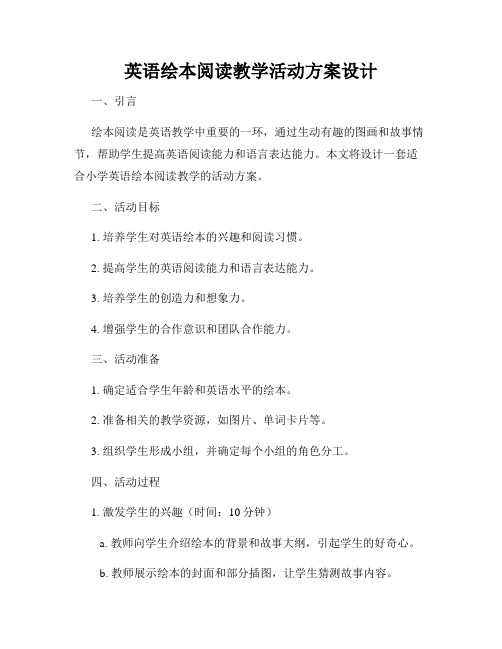
英语绘本阅读教学活动方案设计一、引言绘本阅读是英语教学中重要的一环,通过生动有趣的图画和故事情节,帮助学生提高英语阅读能力和语言表达能力。
本文将设计一套适合小学英语绘本阅读教学的活动方案。
二、活动目标1. 培养学生对英语绘本的兴趣和阅读习惯。
2. 提高学生的英语阅读能力和语言表达能力。
3. 培养学生的创造力和想象力。
4. 增强学生的合作意识和团队合作能力。
三、活动准备1. 确定适合学生年龄和英语水平的绘本。
2. 准备相关的教学资源,如图片、单词卡片等。
3. 组织学生形成小组,并确定每个小组的角色分工。
四、活动过程1. 激发学生的兴趣(时间:10分钟)a. 教师向学生介绍绘本的背景和故事大纲,引起学生的好奇心。
b. 教师展示绘本的封面和部分插图,让学生猜测故事内容。
c. 学生自由发表对绘本的感受和期待。
2. 预测故事情节(时间:10分钟)a. 学生分小组,根据绘本的封面和插图预测故事情节,并用英语讨论。
b. 每个小组派出一名代表向全班介绍他们的预测结果。
3. 绘本阅读(时间:20分钟)a. 教师将绘本的故事逐句朗读给学生,注意语音语调的模仿和情感表达。
b. 学生跟读和朗读绘本的部分对话或重要语句,同时教师解释生词和句子结构。
c. 小组内学生互相讨论绘本的问题和理解,答疑解惑。
4. 绘本探究(时间:30分钟)a. 学生分小组进行绘本探究活动,探索故事中的重要人物、地点和事件。
b. 每个小组选择一个重要场景,并用画图或模型的形式展示给全班。
c. 小组展示后,全班学生根据展示内容回答问题或表达自己的观点。
5. 创作活动(时间:30分钟)a. 每个小组共同创作一个与绘本相关的故事或角色,并设计绘本封面。
b. 学生利用所学的英语知识,描述他们创作出来的故事或角色。
c. 小组成员互相交流和修改,最终确定最好的作品,并进行展示。
六、活动总结1. 教师与学生一起回顾本次活动的过程和成果。
2. 学生发表对绘本阅读教学活动的体验和感想。
小学英语绘本课教案模板

教学对象:小学三年级教学目标:1. 知识目标:学生能够理解绘本《My First Day at School》的主要内容和情节,并能正确拼读和书写绘本中的关键词汇。
2. 能力目标:通过绘本阅读,提升学生的英语听、说、读、写能力,培养学生对英语学习的兴趣。
3. 情感目标:通过绘本故事,让学生感受到新环境下的适应与成长,培养他们的自信心和勇气。
教学重难点:1. 教学重点:绘本内容的理解,关键词汇的拼读和书写。
2. 教学难点:学生能够运用绘本中的句型进行简单的角色扮演,提高口语表达能力。
教学准备:1. 教学课件:绘本《My First Day at School》电子版、PPT课件。
2. 教学道具:绘本、图片、单词卡片、角色扮演道具等。
3. 教学软件:多媒体教学设备、录音设备。
教学过程:一、导入(5分钟)1. 教师通过提问,引导学生回忆自己第一天上学的情景,激发学生的兴趣。
2. 教师简要介绍绘本《My First Day at School》的作者和内容。
二、绘本阅读(15分钟)1. 教师播放绘本电子版,让学生整体感知故事内容。
2. 教师带领学生逐页阅读绘本,引导学生理解故事情节。
3. 教师提问,检查学生对绘本内容的理解。
三、词汇学习(10分钟)1. 教师带领学生学习绘本中的关键词汇,如:school, classroom, teacher, student, first day, etc.2. 教师通过图片、单词卡片等方式,帮助学生记忆单词。
3. 学生进行单词拼读练习,巩固所学词汇。
四、角色扮演(10分钟)1. 教师将学生分成小组,每组选择一个角色进行角色扮演。
2. 教师提供情景,让学生运用绘本中的句型进行对话。
3. 教师巡回指导,纠正学生的发音和语法错误。
五、总结与作业(5分钟)1. 教师总结本节课的学习内容,强调绘本故事中的成长和勇气。
2. 布置作业:让学生回家后与家长分享绘本故事,并尝试用所学词汇进行简单的对话。
小学英语绘本故事教案模板

教学目标:1. 让学生通过绘本故事,了解并学习英语日常用语。
2. 培养学生的阅读兴趣,提高学生的英语口语表达能力。
3. 培养学生的团队合作意识,提高学生的互动交流能力。
教学重点:1. 学生能够正确理解绘本故事内容,掌握故事中的英语日常用语。
2. 学生能够运用所学英语日常用语进行简单交流。
教学难点:1. 学生能够熟练运用故事中的英语日常用语。
2. 学生能够在实际生活中运用所学英语知识。
教学准备:1. 绘本《小熊学英语》2. 英文卡片3. 多媒体设备教学过程:一、导入1. 教师与学生用简单的英语进行问候,活跃课堂气氛。
2. 教师简要介绍绘本《小熊学英语》的内容。
二、绘本阅读1. 教师引导学生一起阅读绘本,让学生了解故事情节。
2. 教师提问,引导学生思考故事中的问题,加深对故事的理解。
三、学习英语日常用语1. 教师根据绘本内容,挑选出适合学生学习的英语日常用语。
2. 教师带领学生朗读英语日常用语,并讲解其含义。
3. 学生跟读,教师纠正发音。
四、角色扮演1. 教师将学生分成小组,每组选出一个代表小熊,其他学生扮演故事中的角色。
2. 学生根据绘本内容,进行角色扮演,运用所学英语日常用语进行对话。
五、互动交流1. 教师组织学生进行小组讨论,分享自己在绘本故事中的收获。
2. 学生运用所学英语日常用语,进行互动交流。
六、总结1. 教师总结本节课所学内容,强调英语日常用语的重要性。
2. 学生回顾所学英语日常用语,并尝试在实际生活中运用。
教学评价:1. 学生在绘本阅读过程中,能否正确理解故事内容。
2. 学生在角色扮演和互动交流中,能否熟练运用所学英语日常用语。
3. 学生对英语学习的兴趣和积极性。
教学反思:1. 教师应根据学生的实际情况,调整教学方法和进度。
2. 教师应注重培养学生的英语口语表达能力,提高学生的英语学习兴趣。
3. 教师应鼓励学生在实际生活中运用所学英语知识,提高英语综合运用能力。
小学英语绘本教案模板
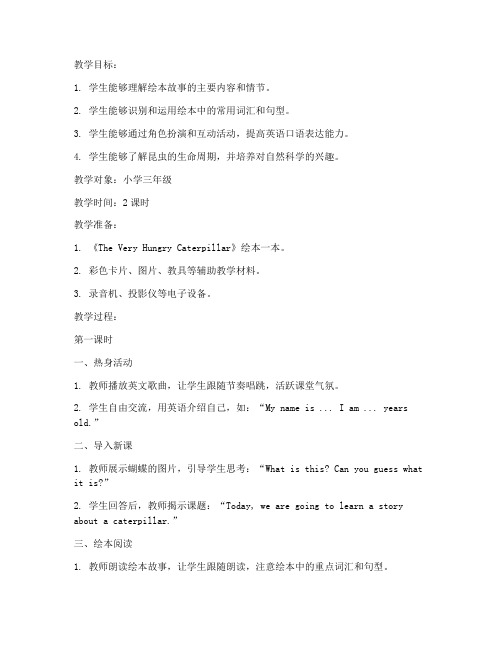
教学目标:1. 学生能够理解绘本故事的主要内容和情节。
2. 学生能够识别和运用绘本中的常用词汇和句型。
3. 学生能够通过角色扮演和互动活动,提高英语口语表达能力。
4. 学生能够了解昆虫的生命周期,并培养对自然科学的兴趣。
教学对象:小学三年级教学时间:2课时教学准备:1. 《The Very Hungry Caterpillar》绘本一本。
2. 彩色卡片、图片、教具等辅助教学材料。
3. 录音机、投影仪等电子设备。
教学过程:第一课时一、热身活动1. 教师播放英文歌曲,让学生跟随节奏唱跳,活跃课堂气氛。
2. 学生自由交流,用英语介绍自己,如:“My name is ... I am ... years old.”二、导入新课1. 教师展示蝴蝶的图片,引导学生思考:“What is this? Can you guess what it is?”2. 学生回答后,教师揭示课题:“Today, we are going to learn a story about a caterpillar.”三、绘本阅读1. 教师朗读绘本故事,让学生跟随朗读,注意绘本中的重点词汇和句型。
2. 学生跟读,教师适时纠正发音。
四、词汇教学1. 教师带领学生学习绘本中的重点词汇,如:leaf、apple、orange、grape等。
2. 学生分组,进行词汇接龙游戏,巩固所学词汇。
五、句型教学1. 教师引导学生学习绘本中的常用句型,如:“I like ...”“What do you like?”2. 学生进行角色扮演,运用所学句型进行对话。
六、总结与拓展1. 教师总结本节课所学内容,强调重点词汇和句型。
2. 学生进行小组讨论,分享自己对昆虫生命周期的了解。
第二课时一、复习导入1. 教师带领学生回顾上一节课所学内容,提问:“What did we learn last class?”2. 学生回答,教师给予肯定和鼓励。
二、角色扮演1. 教师将学生分成小组,每组选择一个角色,如:Caterpillar、Butterfly等。
小学绘本课教案模板英语
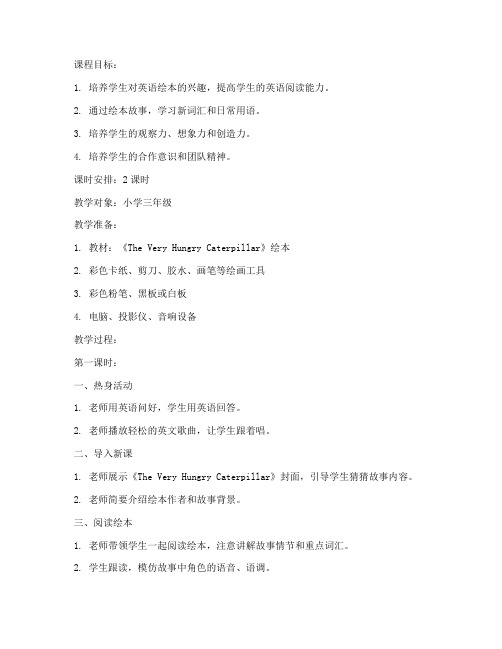
课程目标:1. 培养学生对英语绘本的兴趣,提高学生的英语阅读能力。
2. 通过绘本故事,学习新词汇和日常用语。
3. 培养学生的观察力、想象力和创造力。
4. 培养学生的合作意识和团队精神。
课时安排:2课时教学对象:小学三年级教学准备:1. 教材:《The Very Hungry Caterpillar》绘本2. 彩色卡纸、剪刀、胶水、画笔等绘画工具3. 彩色粉笔、黑板或白板4. 电脑、投影仪、音响设备教学过程:第一课时:一、热身活动1. 老师用英语问好,学生用英语回答。
2. 老师播放轻松的英文歌曲,让学生跟着唱。
二、导入新课1. 老师展示《The Very Hungry Caterpillar》封面,引导学生猜猜故事内容。
2. 老师简要介绍绘本作者和故事背景。
三、阅读绘本1. 老师带领学生一起阅读绘本,注意讲解故事情节和重点词汇。
2. 学生跟读,模仿故事中角色的语音、语调。
四、词汇学习1. 老师引导学生找出绘本中的新词汇,如:fruit、caterpillar、chrysalis等。
2. 学生用卡片游戏复习新词汇,如:单词接龙、你画我猜等。
五、总结与拓展1. 老师引导学生总结故事主题,如:勤奋、坚持、成长等。
2. 学生发挥想象力,用绘画形式表现故事情节。
第二课时:一、复习导入1. 老师用英语提问:“Do you remember the story of The Very Hungry Caterpillar?”2. 学生用英语回答,复述故事情节。
二、小组活动1. 将学生分成若干小组,每组准备一幅表现故事情节的画。
2. 学生用彩色卡纸、剪刀、胶水等工具制作画。
3. 小组成员互相帮助,共同完成画作。
三、展示与评价1. 各小组展示自己的作品,讲述画作背后的故事。
2. 老师和学生共同评价各小组的作品,评选出“最佳创意奖”、“最佳合作奖”等。
四、总结与反思1. 老师引导学生回顾本节课所学内容,总结绘本故事的主题。
小学英语绘本故事阅读活动方案

小学英语绘本故事阅读活动方案一、指导思想小学阶段开设英语课程的目的是培养学生学习英语的积极情感,形成初步的英语语感,为其打好语音、语调基础,最终使学生具备初步的用所学英语进行交流的能力。
阅读是语言学习的一个重要方面。
它可以帮助学生得到乐趣,获取信息,培养学生的英语阅读理解能力,使学生养成良好的英语阅读习惯,具有正确的阅读技巧,拥有主动学习的能力和合作的精神,为终身学习打下基础。
二、总体目标面向全体学生,注重素质教育。
关注每个学生的情感,激发他们学习英语的兴趣,激发学生广泛的阅读兴趣,使学生喜欢阅读,感受阅读的乐趣。
.引导学生注重积累,注重阅读感受和体验,培养语感。
培养学生良好的阅读习惯。
增强学生阅读理解和分析鉴赏能力。
使他们在学习过程中发展综合语言运用能力,提高人文素养。
三、阅读目的1.扩大学生的词汇量。
通过阅读,让学生掌握更多的词汇,进一步提高英语的阅读水平和范围,让他们的生活不再仅限于课堂上,让他们体验到学习英语的快乐。
2.积极营造书香校园,激发学生英语阅读的兴趣,培养学生良好的英语阅读习惯,拓宽学生的英语视野,全面提高学生的综合英语素养。
3.介绍英美文化背景,帮助学生理解不同文化背景下的习惯用语并增加学习兴趣,拓宽眼界,增长知识。
4.通过英语课外阅读,丰富英语涵养,提升英语能力,挖掘英语潜力,借助多种形式的英语课外活动,全面展示学生的英语阅读成果,建立自信、激发动力,为学生的可持续发展奠定厚实的基础。
四、阅读对象:三至五年级学生五、活动措施:1.创设阅读氛围建立班级英语角及其它学习阵地。
合理利用外研社所赠送图书,引导学生充分利用教室内外的橱窗、黑板报、手抄报等阵地展示经典佳句,展示学生的阅读成果,营造诵读的氛围。
2.指导阅读方法帮助学生制订阅读计划,指导阅读方法,组织学生开展形式多样的阅读交流活动,对不喜欢阅读的学生,要特别关注,经常引导、鼓励、熏陶、点拨。
3.保证阅读时间(1)班级绘本学习,每周精选一绘本。
小学绘本英语活动方案
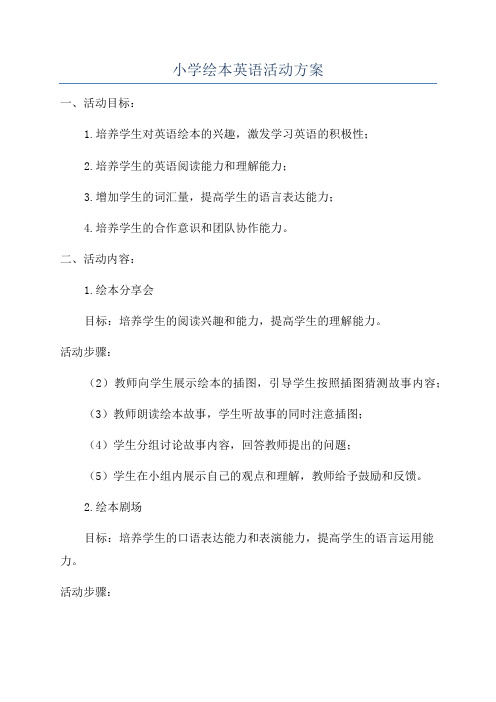
小学绘本英语活动方案一、活动目标:1.培养学生对英语绘本的兴趣,激发学习英语的积极性;2.培养学生的英语阅读能力和理解能力;3.增加学生的词汇量,提高学生的语言表达能力;4.培养学生的合作意识和团队协作能力。
二、活动内容:1.绘本分享会目标:培养学生的阅读兴趣和能力,提高学生的理解能力。
活动步骤:(2)教师向学生展示绘本的插图,引导学生按照插图猜测故事内容;(3)教师朗读绘本故事,学生听故事的同时注意插图;(4)学生分组讨论故事内容,回答教师提出的问题;(5)学生在小组内展示自己的观点和理解,教师给予鼓励和反馈。
2.绘本剧场目标:培养学生的口语表达能力和表演能力,提高学生的语言运用能力。
活动步骤:(1)教师选择一本有趣的英语绘本,将绘本故事改编成小剧本,分配角色给学生;(2)教师给学生讲解剧本的内容和角色特点,帮助学生理解并诠释角色;(3)学生分组进行角色排练,通过反复练习熟悉角色台词和动作;(4)学生进行剧场表演,教师评价学生的表演,鼓励学生互相欣赏和表扬。
3.绘本创作目标:培养学生的创造力和想象力,提高学生的写作能力。
活动步骤:(1)教师给学生展示一些有趣的绘本作品,让学生欣赏和品味;(2)教师激发学生的思维,引导学生讲述自己的小故事或者想象未来的故事;(3)学生根据自己的故事创作绘本,包括文字和插图;(4)学生互相分享自己的创作,教师鼓励学生互相交流和评价。
4.绘本拓展目标:拓宽学生的知识面和视野,增强学生的阅读广度和深度。
活动步骤:(1)教师邀请一些外语专家或者英语母语的志愿者来给学生讲述他们喜欢的英语绘本故事;(2)学生在听故事的同时,提问并交流自己的观点和理解;(3)学生根据自己的理解和感受,进行创作和表达,比如写读后感、画插图等;(4)学生互相分享自己的创作,教师引导学生进行讨论和交流。
三、活动收获:通过以上一系列的绘本英语活动,学生可以培养自己对英语的兴趣和积极性,提高阅读和理解能力,增加词汇量,并培养学生的合作意识和团队协作能力。
一年级英语绘本阅读社团活动方案

一年级英语绘本阅读社团活动方案全文共3篇示例,供读者参考篇1Title: First Grade English Picture Book Reading Club Activity PlanIntroduction:Reading picture books is not only a fun and engaging activity for students, but it also helps to improve their English language skills and fosters a love for reading. In order to promote reading among first-grade students, we have devised a plan for an English Picture Book Reading Club. This club will provide a platform for students to come together, read, discuss, and enjoy picture books in English.Goals:1. Foster a love for reading among first-grade students.2. Improve English language skills such as vocabulary, comprehension, and fluency.3. Develop critical thinking and analytical skills through discussions and activities related to picture books.Activities:1. Weekly Reading Sessions: The club will meet once a week for a reading session where students will have the opportunity to read a selected picture book together. The books will be chosen based on their level of difficulty and themes that are suitable for first-grade students.2. Discussion and Comprehension Activities: After reading the book, students will engage in discussions about the story, characters, and themes. They will also participate in comprehension activities such as answering questions about the book, summarizing the story, and making predictions about what might happen next.3. Creative Writing and Art Projects: To further enhance the reading experience, students will be encouraged to participate in creative writing and art projects inspired by the picture books they have read. This could include writing their own stories, creating illustrations, or acting out scenes from the book.4. Guest Author Visits: To inspire students and provide them with a deeper insight into the world of picture books, we will invite guest authors to visit the club and talk about their work. This will also give students the opportunity to ask questions and learn more about the process of creating a picture book.5. Book Swaps and Recommendations: In order to encourage students to continue reading outside of the club, we will organize book swaps where students can exchange picture books with each other. Students will also be encouraged to recommend their favorite books to their classmates.Benefits:1. Improved English language skills: Reading in English will help students expand their vocabulary, improve their comprehension, and enhance their fluency.2. Critical thinking and analytical skills: Discussions and activities related to picture books will help students develop their critical thinking and analytical skills.3. Creativity and imagination: Engaging with picture books will stimulate students' creativity and imagination, leading to the development of their artistic and storytelling abilities.Conclusion:The First Grade English Picture Book Reading Club is an excellent opportunity for students to develop a love for reading, improve their English language skills, and foster their creativity and imagination. By participating in this club, students will not only have fun but also gain valuable skills that will benefit themin their academic and personal lives. We are excited to launch this club and look forward to a successful and enriching reading experience for all participants.篇2Title: First Grade English Picture Book Reading Club Activity PlanIntroduction:The First Grade English Picture Book Reading Club aims to promote a love for reading among first-grade students and improve their English proficiency. Through interactive and engaging activities, students will have the opportunity to explore different genres of picture books, develop their language skills, and enhance their creativity. This activity plan outlines the structure and objectives of the reading club, as well as the various activities that will be conducted throughout the academic year.Objective:1. To cultivate a love for reading among first-grade students.2. To improve students' English language skills.3. To enhance students' creativity and imagination.4. To provide a platform for students to share their thoughts and ideas.Structure of the Reading Club:1. Frequency: The reading club will meet once a week during lunch break or after school.2. Duration: Each session will last for 45 minutes to 1 hour.3. Membership: The reading club is open to all first-grade students who are interested in participating.4. Materials: A selection of age-appropriate English picture books will be provided for the students to read.Activities:1. Storytelling: Students will take turns reading aloud from a picture book and discussing the plot, characters, and themes with their peers.2. Creative Writing: Students will be encouraged to write their own short stories inspired by the picture books they have read.3. Art and Craft: Students will engage in art and craft activities related to the picture books, such as drawing theirfavorite characters or creating a diorama of a scene from the story.4. Book Reviews: Students will be asked to write book reviews and share their opinions on the picture books they have read with the rest of the group.5. Guest Authors: Occasionally, guest authors or illustrators will be invited to conduct special workshops and readings with the students.Assessment:1. Participation: Students will be assessed based on their active participation in the reading club activities.2. Creativity: Students' creative writing pieces and artwork will be evaluated for originality and imagination.3. Language Skills: Students' language proficiency will be assessed through their storytelling, discussions, and book reviews.4. Peer Evaluation: Students will be encouraged to provide feedback and support to their peers during the activities.Conclusion:The First Grade English Picture Book Reading Club is designed to instill a love for reading, enhance language skills, and foster creativity among first-grade students. By engaging in a variety of interactive and stimulating activities, students will have the opportunity to explore the world of English picture books and develop a lifelong passion for literature. We believe that this reading club will inspire students to become avid readers and confident communicators in the future.篇3Title: First Grade English Picture Book Reading Club Activity PlanIntroduction:The First Grade English Picture Book Reading Club is aimed at promoting early literacy skills among first-grade students through engaging and interactive activities centered around picture books. In this activity plan, we will outline the various components of the club, including the selection of picture books, reading activities, group discussions, creative projects, and other fun and educational activities that will enhance students' love for reading and language development.Objective:The main objective of the First Grade English Picture Book Reading Club is to cultivate a love for reading among students and foster their language development skills through exposure to high-quality picture books. By engaging in interactive reading activities and discussions, students will improve their vocabulary, comprehension, and critical thinking skills while also increasing their confidence and motivation to read independently.Activity Plan:1. Selection of Picture Books:- Select a variety of picture books that cater to different interests and reading levels.- Choose books with colorful illustrations, engaging storylines, and opportunities for vocabulary development.- Rotate books regularly to keep students excited and engaged with new titles.2. Reading Activities:- Read aloud sessions: Teachers or volunteers can read aloud selected picture books to the students, using expressive tones and gestures to bring the stories to life.- Paired reading: Pair students up and have them take turns reading aloud to each other, offering support and encouragement.- Independent reading: Provide quiet reading time for students to read on their own, allowing them to explore books at their own pace.3. Group Discussions:- After reading a picture book, facilitate group discussions to engage students in analyzing the plot, characters, themes, and moral lessons of the story.- Encourage students to share their thoughts and opinions on the book, fostering critical thinking and communication skills.- Use open-ended questions to spark conversations and promote active participation from all students.4. Creative Projects:- Encourage students to participate in creative projects related to the picture books, such as art activities, writing assignments, role-playing, or creating their own stories inspired by the books.- Provide opportunities for students to showcase their creativity and imagination, reinforcing the concepts learned from the books.5. Fun and Educational Activities:- Organize games, quizzes, puzzles, and other interactive activities related to the picture books, such as matching games, charades, or scavenger hunts.- Incorporate songs, rhymes, and chants into the club activities to reinforce vocabulary and language skills in a fun and engaging way.- Celebrate students' achievements and progress with certificates, prizes, or special events to motivate and reward their efforts.Conclusion:The First Grade English Picture Book Reading Club is a valuable resource for promoting early literacy skills and language development among first-grade students. By engaging in interactive reading activities, group discussions, creative projects, and fun educational activities, students will foster a love for reading, improve their language skills, and develop critical thinking and communication skills. Through the collaboration ofteachers, parents, volunteers, and students, the club will create a positive and enriching learning environment that inspires a lifelong passion for reading and learning.。
英文绘本阅读活动设计方案

英文绘本阅读活动设计方案一、教学内容本节课选取的教材为《丽声绘本图书馆》系列的第四级绘本,绘本名为《Bunny's New Friend》。
绘本讲述了小兔子Bunny在森林里寻找新朋友的过程中,遇到了许多动物,与刺猬成为好朋友的故事。
绘本内容丰富,插图生动有趣,适合小学四年级学生阅读。
二、教学目标1. 让学生能够听懂、读懂绘本《Bunny's New Friend》的故事内容,并能简要复述故事情节。
2. 学生能够运用所学词汇和句型,描述动物的外貌特征和喜好。
3. 培养学生热爱阅读,乐于分享的情感态度,提高学生的人文素养。
三、教学难点与重点重点:学生能够听懂、读懂绘本《Bunny's New Friend》的故事内容,并能简要复述故事情节。
难点:学生能够运用所学词汇和句型,描述动物的外貌特征和喜好。
四、教具与学具准备教具:多媒体课件、绘本《Bunny's New Friend》、动物卡片、词汇卡片。
学具:学生用书、练习本、彩笔。
五、教学过程1. 热身活动(5分钟)教师播放英语歌曲《Old MacDonald Had a Farm》,引导学生跟着歌曲一起唱,激发学生的学习兴趣。
接着,教师邀请几位学生模仿歌曲中的动物叫声,引入本节课的主题。
2. 引入新课(10分钟)教师简要介绍绘本《Bunny's New Friend》的故事情节,引导学生关注故事中的动物角色。
然后,教师出示动物卡片,让学生用英语说出这些动物的名称。
3. 绘本阅读(10分钟)教师带领学生一起阅读绘本《Bunny's New Friend》,边读边引导学生关注故事中的细节。
教师提问学生关于故事情节的问题,如“Who is Bunny's new friend? What does Bunny like to do?”等,检查学生对故事的理解。
4. 活动拓展(10分钟)(1)学生回家后,跟家长一起阅读绘本《Bunny's New Friend》,并简要复述故事情节。
小学英语二年级绘本阅读开展计划
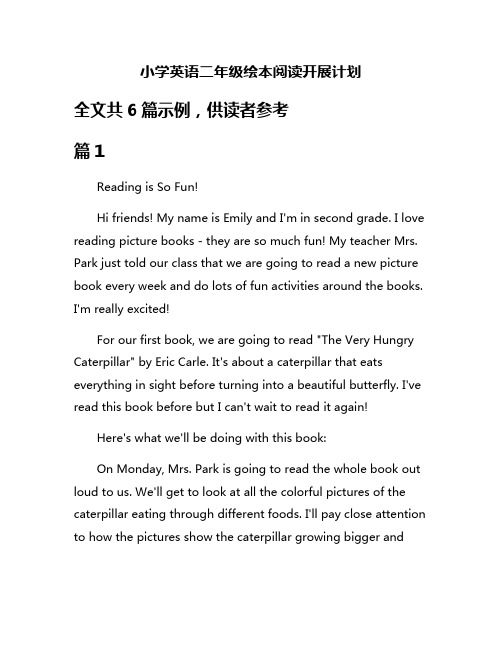
小学英语二年级绘本阅读开展计划全文共6篇示例,供读者参考篇1Reading is So Fun!Hi friends! My name is Emily and I'm in second grade. I love reading picture books - they are so much fun! My teacher Mrs. Park just told our class that we are going to read a new picture book every week and do lots of fun activities around the books. I'm really excited!For our first book, we are going to read "The Very Hungry Caterpillar" by Eric Carle. It's about a caterpillar that eats everything in sight before turning into a beautiful butterfly. I've read this book before but I can't wait to read it again!Here's what we'll be doing with this book:On Monday, Mrs. Park is going to read the whole book out loud to us. We'll get to look at all the colorful pictures of the caterpillar eating through different foods. I'll pay close attention to how the pictures show the caterpillar growing bigger andbigger from eating so much! After she finishes reading, we'll go around the class and each say our favorite part.On Tuesday, we're going to make our own caterpillar drawings. Mrs. Park will give us big pieces of green paper that we can cut into circles for the caterpillar's body. Then we can decorate the circles with crayons, markers, or other craft supplies to make it look like the caterpillar from the book. I'm going to try to make mine look really fat and full from eating all that food!Wednesday is my favorite day for this book. We're going to act it out! A few kids will get to dress up as the caterpillar using a caterpillar costume Mrs. Park has. As the book gets read again, the "caterpillars" will move around the room "eating" things. Like they'll pretend to eat an apple, a piece of cake, and all the other foods the caterpillar ate. At the end they'll make a cocoon with a blanket and then come out as a butterfly! I hope I get picked to be the caterpillar.For Thursday, we're going to learn about the life cycle of real butterflies. Mrs. Park has some pictures and a short video she'll show us about how a caterpillar turns into a butterfly after being in its cocoon for awhile. She said we might even get to see some real caterpillars up close in a container! I'll make sure to observe them carefully.Then on Friday, we'll review everything we learned about the book and butterflies. We'll go over new vocabulary words we learned like "cocoon," talk about our favorite parts, and draw pictures showing the different stages of the life cycle. At the end, Mrs. Park said if we did a good job, we'll get to eat...caterpillar snacks! Made out of green grapes, pretzels, and pieces of string cheese. How cool!I can't wait to do all these fun activities with "The Very Hungry Caterpillar" book. Learning while having fun is the best. I'm really looking forward to the next book we'll read and celebrate too. Reading is so much fun in second grade!篇2My Reading Adventure!Hi there! My name is Emma and I'm a student in 2nd grade. This year, our teacher Mrs. Smith has an exciting reading plan for us called "My Reading Adventure!" I can't wait to tell you all about it.Reading is one of my favorite things to do. I just love getting lost in a good book and using my imagination to picture the characters and settings. Mrs. Smith says reading helps us learnnew words, improves our speaking and writing skills, and lets us go on adventures from the comfort of our classroom!For our reading plan this year, each week we will read a different storybook together as a class. Mrs. Smith has picked out some really cool books that I think we're all going to love. After we read each book, we get to do a fun activity or project related to the story.Here's what a typical week looks like:Monday: Meet the BookOn Mondays, Mrs. Smith introduces us to the new book we'll be reading that week. She shows us the front cover and we make predictions about what we think the story will be about based on the title and illustrations. Then she reads us the first couple of pages to get us hooked!Tuesday: Let's Read!We start reading the book together as a class on Tuesdays. Mrs. Smith does lot of great voices for the different characters which makes it really fun to follow along. We take turns reading parts aloud when we can. If there are words I don't know, I raise my hand and Mrs. Smith explains what they mean.Wednesday: Dive DeeperOn Wednesdays, we reread the parts of the book we covered on Tuesday. Then we talk more about the story - what's happening so far, who the main characters are, what we think will happen next, and so on. Mrs. Smith asks us lots of questions to make sure we're understanding everything properly.Thursday: Extend the AdventureThis is one of my favorite days! On Thursdays, we finish reading the book together. Once we've reached the ending, we get to work on an extension activity related to the story. Sometimes we'll act out scenes from the book, create artwork inspired by it, or even write our own alternative endings. The activities allow us to really use our creativity and imaginations.Friday: Share & ReflectOn the last day of the week, a few students get to share the projects they worked on with the rest of the class. We talk about our favorite parts of the book and what lessons or morals we can take away from the story. Mrs. Smith also introduces a few simple comprehension activities to gauge how well we understood the major events and characters.I'm really excited about all the books we'll be exploring over the coming months. Reading them together as a class makes iteasier for me to understand and appreciate the stories. And the activities let me dig deeper and have fun with the books in different ways.Some of the books I'm most looking forward to are fairy tales like Cinderella and Jack and the Beanstalk, as well as stories about animals, friendship, and going on adventures. I also hope we'll read books that teach us about different cultures from around the world.Reading the books together and doing the activities is a great way for all of us students to build our English skills while being entertained at the same time. I can't wait to go on many more reading adventures with my classmates this year! Maybe you could start your own reading adventure at home or school too. Happy reading!篇3My Reading Journey with Picture BooksHi, my name is Emma and I'm in second grade. I love reading picture books! When I was little, my mommy and daddy read lots of picture books to me before bedtime. Now that I'm in second grade, I get to read picture books in my English class too. It's so much fun!In my class, we have a special reading time every day just for picture books. My teacher, Mrs. Adams, has a big bookshelf full of amazing picture books. Some of them have funny stories that make me giggle. Others have beautiful pictures that look like paintings. And some teach me cool facts about animals, places around the world, or even famous people!Mrs. Adams starts our picture book time by showing us the cover and asking us what we think the book might be about. We make predictions based on the title and the pictures on the front. Then she reads the whole book to us while showing the pictures on each page.After she finishes reading, we talk about the story together. Mrs. Adams asks us questions like "What was your favorite part?" or "Why do you think the character did that?" Sometimes she'll ask us how we felt when a certain event happened. I love sharing my thoughts and hearing what my classmates have to say too.We also look closely at the illustrations and talk about how the pictures help tell the story. The illustrations in picture books are so pretty and detailed. The artists who create them are really talented! Looking at the pictures helps me understand what's happening better than just reading the words.Every few weeks, Mrs. Adams introduces a new picture book author or illustrator to our class. We learn about their lives and the other books they've made. It's cool to see the different artistic styles between illustrators. My favorite author/illustrator we've learned about is Eric Carle who wrote The Very Hungry Caterpillar. I loved his bright, collage-like pictures!After we've read and discussed a picture book as a class, we get to borrow it and take it home to read again. My little brother who's in kindergarten loves it when I read picture books to him, just like my parents did for me. Reading out loud helps me practice my English fluency.In addition to just reading the picture books, we also get to do fun extension activities and projects based on the stories. Sometimes we'll act out scenes from the book like a little play. Other times we'll make crafts inspired by the illustrations, kind of like recreating the art! We've also done writing assignments where we change the ending or imagine what happens next after the book is over.One of my favorite activities is when we get to write and illustrate our very own picture books. First, we come up with ideas for characters and a plot line. Then we draft and revise our stories. Finally, we create illustrations for each page and put thewhole book together with construction paper and staples. Sharing our finished picture books with the class is the best!We even had a picture book author visit our school last month which was awesome. He talked about how he gets ideas for stories and showed us his process for writing them. He had some of his original art too which was incredible to see in person. It made me want to be an author and illustrator when I grow up!Reading picture books has really helped me improve my English this year. The simple language and plots are easy for me to understand, but I'm still learning lots of new vocabulary words. Looking at the pictures gives me helpful context clues for words I don't know. And the repetitive phrases and rhymes help words and sentences stick in my brain.Picture books have also taught me about story structure like setting, characters, conflict, and resolution. I can identify the beginning, middle, and end of stories now. Plus, I've learned skills like making predictions, visualizing, summarizing, and making connections between books and my own life.More than just developing my English abilities though, picture books have opened up my imagination and creativity. They've allowed me to explore so many different worlds, go onfun adventures, and see through others' perspectives - all from the comfort of the classroom! Books truly are magical.That's why I'm so excited we get to keep reading picture books in second grade and maybe even third grade too. My love of reading is just beginning with these age-appropriate, engaging stories. Who knows where my reading journey will take me next? Maybe one day I'll be a famous author like the ones I admire! For now, I'm just grateful for picture books and how they've helped turn me into a reader. Thanks for letting me share my thoughts!篇4My Reading Adventure with Picture BooksHi there! My name is Emma and I'm in 2nd grade. I love reading, especially picture books! My teacher Mrs. Parker just told our class about a really fun reading plan we're going to do this year with lots of amazing picture books. I'm so excited to tell you all about it!First, let me tell you why I love picture books so much. The pictures are just so bright, colorful and detailed - they really bring the stories to life. I can stare at the illustrations for hours, discovering new little details each time. The words are usuallypretty simple too, which makes the books nice and easy for me to read by myself.But the best part is how the words and pictures work together to tell creative, imaginative stories that take me on adventures to magical worlds. One minute I'm tucked under my covers at bedtime, and the next I'm soaring through the sky with a friendly dragon or exploring an enchanted forest filled with talking animals! It's like the pictures open a door to anywhere my mind can dream up.Mrs. Parker says reading picture books is super important for little kids like me because it helps our brains develop in all sorts of cool ways. The pictures help us learn how to interpret visual information and make connections between words and images. Following the stories improves our listening comprehension too. Plus, it exposes us to lots of new vocabulary words in context so we can keep building our language skills. Who knew reading picture books could be so educational and fun at the same time?Okay, so let me fill you in on this awesome picture book reading plan! Each week, Mrs. Parker is going to introduce our class to a brand new picture book. First, she'll show us the front cover and ask us to make predictions about what we think the book will be about just from the title and pictures. Then she'llread the whole book aloud to us while showing the pictures on the big screen.After the reading, we'll discuss our favorite parts and share anything that confused us. We can ask Mrs. Parker to re-read tricky sections. Then we'll talk about the deeper meanings behind the story and what lessons we can learn from it. I can't wait to hear everybody's creative thoughts and interpretations!But that's not all - the fun is just getting started! Each week, we'll have special activities and projects related to that book. One week we might act out the story by dressing up and putting on a play. Another week we could make our own picture books, writing and illustrating new stories inspired by the one we read. We might even get to meet video calls with the author or illustrator themselves and ask them questions about their process!On other weeks, we'll dive deeper into the book's themes through crafts, songs, games and more. If a book is about caring for animals, we could build pet houses for fowl that live behind our school. For books that take place in other countries, we might locate them on a map, learn about their cultures and cuisines, and try our hand at some traditional dances. Thepossibilities are endless for learning in an engaging, interactive way!I'm most excited about our picture book reading buddies. We'll each get matched up with a kindergarten or 1st grade student to be their reading buddy for the year. Once a week during buddy time, we'll read that week's book aloud to our little buddies and do a related craft or activity together. It'll be so fun to explore the stories with fresh eyes and share my reading experience! I just hope I get paired with a buddy who loves picture books as much as I do.At the end of the year, we're going to have a huge picture book fair to celebrate everything we've learned. Our classes will put together our own handmade picture books and perform skits based on our favorite stories. We can decorate our classroom doors like the magical worlds from the books too. Our families will be invited to walk through the picture book museum we've created and see our hard work first-hand. I already can't wait to show my parents everything I'll make and perform!This reading plan sounds like it'll be such an awesome, imaginative way for my classmates and me to improve our reading comprehension while nurturing our creativity and bonding over shared stories. I'm sure it'll fill our days with somuch laughter, learning and exploration of the enchanting picture book worlds. Books really are gateways to endless adventures when you open your mind! I better start preparing for the most epic reading journey yet.篇5小学英语二年级绘本阅读开展计划介绍大家好,我是小明,是我们班的二年级学生。
英语绘本故事朗读活动方案及总结
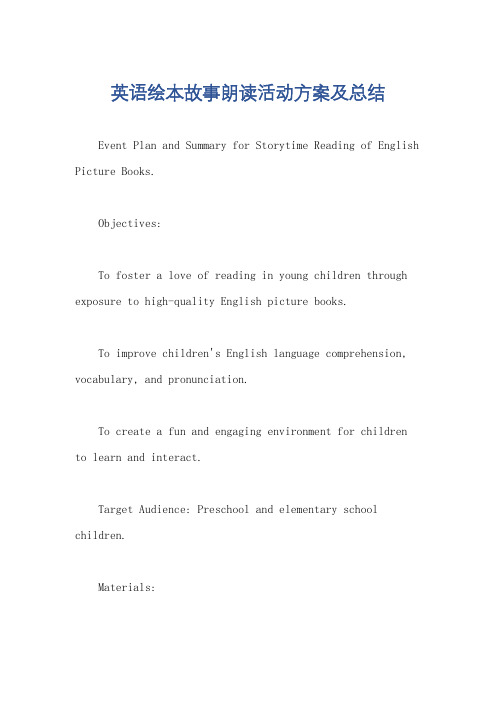
英语绘本故事朗读活动方案及总结Event Plan and Summary for Storytime Reading of English Picture Books.Objectives:To foster a love of reading in young children through exposure to high-quality English picture books.To improve children's English language comprehension, vocabulary, and pronunciation.To create a fun and engaging environment for children to learn and interact.Target Audience: Preschool and elementary school children.Materials:A selection of English picture books.A comfortable seating area.Visual aids (e.g., puppets, props, costumes)。
Procedure:1. Welcome: Begin by introducing yourself andexplaining the purpose of the storytime.2. Warm-up: Lead the children in a short song or gameto get them excited about reading.3. Book Reading: Choose a picture book that is appropriate for the age and interests of the children. Read the book aloud with expression and enthusiasm. Use visual aids to engage the children and make the story come to life.4. Discussion: After reading the book, lead adiscussion about the story. Ask the children questionsabout the characters, setting, plot, and message. Encouragethem to share their thoughts and ideas.5. Activity: Plan an activity related to the book, such as a craft, game, or song. This activity will help children to further engage with the story and reinforce their learning.6. Closing: End the storytime by thanking the children for their participation. Encourage them to continue reading and exploring the world of books.Evaluation:Observe the children's engagement and participation during the storytime.Collect feedback from the children and theirparents/caregivers.Monitor the children's progress in English language acquisition.Summary:The English picture book storytime reading activity was a success. The children were engaged and enthusiastic throughout the event. They enjoyed listening to the books, participating in the discussions, and completing the activities. The storytime helped to foster a love of reading in the children and improved their English language skills.Aim of the Activity:英文绘本阅读活动旨在通过阅读高质量的英文绘本来培养幼儿的阅读兴趣。
英语绘本阅读活动方案
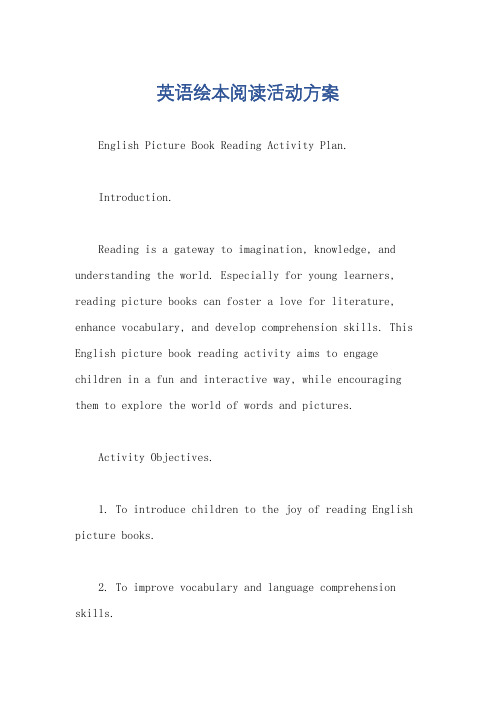
英语绘本阅读活动方案English Picture Book Reading Activity Plan.Introduction.Reading is a gateway to imagination, knowledge, and understanding the world. Especially for young learners, reading picture books can foster a love for literature, enhance vocabulary, and develop comprehension skills. This English picture book reading activity aims to engage children in a fun and interactive way, while encouraging them to explore the world of words and pictures.Activity Objectives.1. To introduce children to the joy of reading English picture books.2. To improve vocabulary and language comprehension skills.3. To foster creativity and imagination through storytelling.4. To encourage children to develop a habit of regular reading.Materials Needed.1. English picture books (age-appropriate and with diverse themes)。
2. Projector or large screen for group reading.3. Audio equipment for storytelling.4. Drawing materials (crayons, markers, paper)。
小学英语绘本讲读教案模板

教学对象:二年级学生教学目标:1. 培养学生对英语绘本的兴趣,提高阅读能力。
2. 通过绘本阅读,帮助学生掌握相关词汇和句型。
3. 培养学生的观察力、想象力和创造力。
教学内容:《Brown bear, brown bear, what do you see?》(棕熊,棕熊,你在看什么?)教学时间:40分钟教学准备:1. 英语绘本《Brown bear, brown bear, what do you see?》2. 彩色图片或实物,如熊、鸟、鱼等3. 多媒体课件4. 录音设备教学过程:一、导入(5分钟)1. 播放绘本中的音乐,让学生感受绘本的氛围。
2. 提问:同学们,你们喜欢听故事吗?今天我们要学习一本有趣的英语绘本。
二、绘本阅读(20分钟)1. 让学生自主阅读绘本,注意观察图片和文字。
2. 教师逐页讲解绘本内容,引导学生理解故事情节。
3. 教师引导学生找出绘本中的重点词汇和句型,如:brown bear, red bird, yellow duck等。
三、互动活动(15分钟)1. 游戏环节:教师出示彩色图片或实物,让学生用英语描述,如:“What do yo u see? I see a red bird.”2. 创意环节:让学生发挥想象力,用自己的语言续写故事,如:“What do you think the brown bear will do next?”四、总结与作业(10分钟)1. 教师总结绘本内容,强调重点词汇和句型。
2. 布置作业:让学生用英语复述故事,或画出自己最喜欢的角色。
教学反思:1. 本节课通过绘本阅读,激发了学生对英语学习的兴趣,提高了他们的阅读能力。
2. 在互动活动中,学生的参与度较高,充分发挥了他们的想象力和创造力。
3. 教师应注重培养学生的语言表达能力和思维能力,提高他们的英语综合运用能力。
教学评价:1. 学生对绘本的兴趣和阅读能力是否有所提高。
2. 学生在互动活动中的表现,如词汇运用、故事复述等。
英语绘本阅读”比赛活动方案

英语绘本故事阅读竞赛活动方案
一、指导思想:
以国家义务教育英语课程标准为指导,认真贯彻落实岑巩县教科局教育工作会议精神,以“创办内涵丰富的学校、成就敢于跨越的老师、培养全面发展的学生”为目标,坚持立德树人,培养全面发展的人。
义务教育阶段英语课程要求学生能够通过英语学习使学生形成初步的综合语言应用能力,促进心智发展,提高综合人文素养。
根据这个总的目标要求,在学校工作计划的安排下,根据本学期英语组的工作计划的安排,特举行本次英语绘本阅读竞赛活动。
二、活动要求:
参赛对象:
参赛内容:以英语绘本故事阅读为主,也可以以表演、角色扮演、讲解等形式。
参赛方式:由班级筛选,每班确定1名学生参赛。
于2019年10月25前上传报名表(附件1)。
参赛要求:根据学生参赛的课题,准备舞台背景音频材料(PPT,音乐,视频等)
三、比赛时间地点:
2019年10月31日下午7点开始(如遇特殊原因根据实际情况调整)羊桥土家族乡中心小学学生广场舞台。
四、赛事组织:
组长:
副组长:
成员:
五、赛事安排:
主持人:
评委教师:
现场纪律:
音乐播放:
录像摄制:
颁奖人员:
奖项设置:
各年级组分别设置一等奖1名,奖金20元/人;二等奖2名,奖金15元/人;三等奖若干名,奖金10元/人。
颁奖方式:比赛结束后现场颁发奖状与奖金。
其他要求:
参赛的学生需事先与家长取得联系,争得家长的同意,在参加比赛的过程中建立相应的安全预案,确保安全,如因交通等其他不可抗拒的因素不能参与,需提前一周告知赛事筹备组。
附件3(注:最后得分为除去最高分和最低分的平均分数)。
英语绘本阅读社团活动方案

英语绘本阅读社团活动方案标题:英语绘本阅读社团活动方案一、活动目标:1. 提高学生的英语阅读理解能力。
2. 培养学生的英语口语表达能力。
3. 通过绘本阅读,激发学生对英语学习的兴趣。
二、活动对象:全体英语爱好者和社团成员。
三、活动内容:1. 英语绘本选择:根据学生的英语水平和兴趣,选择适合的英语绘本进行阅读。
例如,《The Cat in the Hat》,《Green Eggs and Ham》等经典英文绘本。
2. 英语绘本阅读:在指定的时间内,学生独立或小组合作完成绘本阅读,并记录下自己的理解和感悟。
3. 英语绘本分享:组织定期的分享会,让学生用英语讲述自己读过的绘本故事,分享自己的理解和感受。
4. 英语绘本创作:鼓励学生尝试创作自己的英文绘本,以提升他们的创新能力和实践能力。
四、活动流程:1. 绘本选择:在每学期开始时,由社团指导老师和学生共同讨论并确定本学期要阅读的绘本清单。
2. 绘本阅读:每周至少安排一次固定的时间,让学生进行自主阅读。
3. 分享交流:每月举行一次分享会,让学生展示自己的阅读成果。
4. 创作实践:每学期末,鼓励学生尝试创作自己的英文绘本,并在社团活动中进行展示。
五、预期效果:1. 学生的英语阅读理解能力得到提高,能更好地理解和欣赏英文原著。
2. 学生的英语口语表达能力得到锻炼,能更自信地用英语进行交流。
3. 学生对英语学习的兴趣得到激发,更积极主动地投入到英语学习中。
六、注意事项:1. 在选择绘本时,应考虑学生的英语水平和兴趣,确保他们能够理解并喜欢所选的绘本。
2. 在组织分享会时,应注重引导学生用英语进行交流,提升他们的口语表达能力。
3. 在鼓励学生创作绘本时,应提供必要的支持和指导,帮助他们顺利完成创作。
以上就是我们的英语绘本阅读社团活动方案,希望能为学生的英语学习带来新的动力和乐趣。
英语绘本故事朗读活动方案及总结
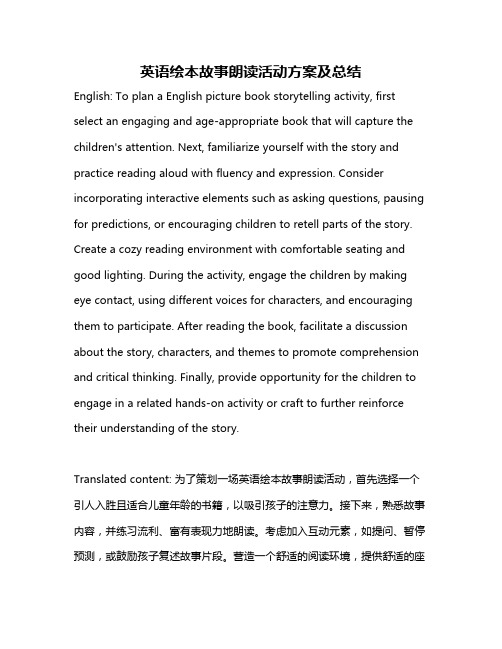
英语绘本故事朗读活动方案及总结English: To plan a English picture book storytelling activity, first select an engaging and age-appropriate book that will capture the children's attention. Next, familiarize yourself with the story and practice reading aloud with fluency and expression. Consider incorporating interactive elements such as asking questions, pausing for predictions, or encouraging children to retell parts of the story. Create a cozy reading environment with comfortable seating and good lighting. During the activity, engage the children by making eye contact, using different voices for characters, and encouraging them to participate. After reading the book, facilitate a discussion about the story, characters, and themes to promote comprehension and critical thinking. Finally, provide opportunity for the children to engage in a related hands-on activity or craft to further reinforce their understanding of the story.Translated content: 为了策划一场英语绘本故事朗读活动,首先选择一个引人入胜且适合儿童年龄的书籍,以吸引孩子的注意力。
小学绘本英语教案模板范文

课程名称:小学绘本英语课程年级:小学三年级教材:《My First English Picture Book》课时: 2课时教学目标:1. 学生能够理解绘本故事的基本内容。
2. 学生能够识别并运用绘本中的关键词汇。
3. 学生能够通过角色扮演和小组讨论提高英语口语表达能力。
教学重点:- 绘本故事的理解- 关键词汇的识别和运用教学难点:- 学生对英语口语表达的自然流畅教学准备:- 绘本《My First English Picture Book》- PPT展示绘本内容- 彩色卡片,用于单词游戏- 纸笔,用于书写练习第一课时一、导入(5分钟)1. 通过歌曲或简短的对话引入英语学习的氛围。
2. 展示绘本封面,激发学生的兴趣。
二、阅读理解(20分钟)1. 小组讨论:让学生根据封面猜测故事内容。
2. 阅读绘本:教师朗读,学生跟读。
3. 问答环节:教师提问,学生回答,检查对故事内容的理解。
三、词汇学习(15分钟)1. 教师展示绘本中的关键词汇,并解释其意思。
2. 学生通过PPT学习单词,并进行拼写练习。
3. 游戏环节:使用彩色卡片进行单词匹配游戏。
四、巩固练习(10分钟)1. 小组合作:学生根据故事内容,用自己的话复述故事。
2. 角色扮演:学生分组扮演故事中的角色,进行简单的对话。
五、总结(5分钟)1. 教师总结本节课的学习内容。
2. 学生分享自己的学习心得。
第二课时一、复习导入(5分钟)1. 回顾上一节课的内容,提问学生关于故事和单词的记忆。
2. 通过简单的游戏复习关键词汇。
二、深入阅读(20分钟)1. 学生独立阅读绘本,尝试找出故事中的细节。
2. 分组讨论:每组选择一个细节,分享给全班同学。
三、口语表达(15分钟)1. 学生根据绘本内容,进行角色扮演。
2. 小组讨论:学生讨论故事中的道德观念或情感体验。
四、拓展活动(10分钟)1. 创意绘画:学生根据故事内容,绘制自己的插画。
2. 故事续写:学生发挥想象力,续写故事结局。
英语绘本故事活动方案
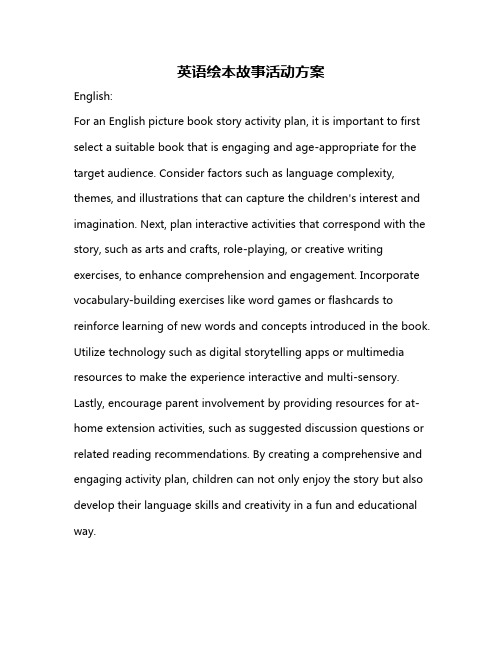
英语绘本故事活动方案English:For an English picture book story activity plan, it is important to first select a suitable book that is engaging and age-appropriate for the target audience. Consider factors such as language complexity, themes, and illustrations that can capture the children's interest and imagination. Next, plan interactive activities that correspond with the story, such as arts and crafts, role-playing, or creative writing exercises, to enhance comprehension and engagement. Incorporate vocabulary-building exercises like word games or flashcards to reinforce learning of new words and concepts introduced in the book. Utilize technology such as digital storytelling apps or multimedia resources to make the experience interactive and multi-sensory. Lastly, encourage parent involvement by providing resources for at-home extension activities, such as suggested discussion questions or related reading recommendations. By creating a comprehensive and engaging activity plan, children can not only enjoy the story but also develop their language skills and creativity in a fun and educational way.中文翻译:对于一份英语绘本故事活动方案,首先要选择一本适合目标受众的,富有吸引力且适合年龄的绘本故事书。
小学英文绘本分享教案模板

课时:1课时年级:一年级教材:《小熊宝宝去旅行》教学目标:1. 通过绘本分享,让学生了解故事内容,培养阅读兴趣。
2. 培养学生运用英语进行简单交流的能力。
3. 培养学生观察、想象和表达能力。
教学重点:1. 学生能够理解故事内容,并能用英语复述。
2. 学生能够运用所学词汇进行简单交流。
教学难点:1. 学生能够理解故事中的抽象概念。
2. 学生能够运用所学词汇进行创造性的表达。
教学过程:一、导入1. 教师用简单的英语问候学生,营造英语氛围。
2. 教师展示绘本封面,引导学生说出书名。
二、阅读绘本1. 教师讲述故事,学生跟读。
2. 教师引导学生观察图片,理解故事内容。
3. 教师提问,检查学生对故事内容的理解。
三、词汇教学1. 教师带领学生学习故事中的新词汇,如:travel, plane, hotel, beach等。
2. 学生通过游戏、歌曲等方式巩固所学词汇。
四、口语练习1. 教师组织学生进行角色扮演,模拟故事场景。
2. 学生用所学词汇进行对话,锻炼口语表达能力。
五、总结与拓展1. 教师引导学生总结故事内容,复述故事。
2. 教师提问,检查学生对故事的理解。
3. 教师布置课后作业,让学生用所学词汇写一篇小作文。
教学反思:1. 教师应关注学生的个体差异,根据学生的实际情况调整教学策略。
2. 教师应创造轻松、愉快的英语学习氛围,激发学生的学习兴趣。
3. 教师应注重培养学生的阅读习惯,提高学生的阅读能力。
4. 教师应关注学生的口语表达能力,提高学生的英语交际能力。
英语绘本故事活动方案
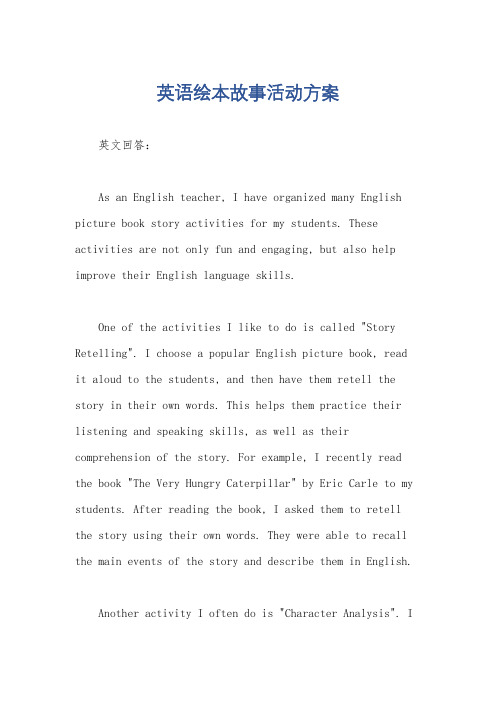
英语绘本故事活动方案英文回答:As an English teacher, I have organized many English picture book story activities for my students. These activities are not only fun and engaging, but also help improve their English language skills.One of the activities I like to do is called "Story Retelling". I choose a popular English picture book, read it aloud to the students, and then have them retell the story in their own words. This helps them practice their listening and speaking skills, as well as their comprehension of the story. For example, I recently read the book "The Very Hungry Caterpillar" by Eric Carle to my students. After reading the book, I asked them to retell the story using their own words. They were able to recall the main events of the story and describe them in English.Another activity I often do is "Character Analysis". Ichoose a character from a picture book and ask the students to describe the character's personality, appearance, and actions. This helps them practice their vocabulary and descriptive skills. For example, after reading the book "Where the Wild Things Are" by Maurice Sendak, I asked my students to describe the main character, Max. They used words like "brave", "adventurous", and "mischievous" to describe him.I also like to do "Creative Writing" activities based on English picture books. After reading a story, I ask the students to write a continuation of the story or a new ending. This encourages them to use their imagination and creativity in English. For example, after reading the book "The Gruffalo" by Julia Donaldson, I asked my students to write a new adventure for the Gruffalo. They came up with creative ideas like the Gruffalo going on a trip around the world or meeting new friends in the forest.Overall, English picture book story activities are a great way to make learning English fun and engaging for students. They not only improve their language skills, butalso spark their creativity and imagination.中文回答:作为一名英语老师,我经常为学生组织英语绘本故事活动。
- 1、下载文档前请自行甄别文档内容的完整性,平台不提供额外的编辑、内容补充、找答案等附加服务。
- 2、"仅部分预览"的文档,不可在线预览部分如存在完整性等问题,可反馈申请退款(可完整预览的文档不适用该条件!)。
- 3、如文档侵犯您的权益,请联系客服反馈,我们会尽快为您处理(人工客服工作时间:9:00-18:30)。
小学英语绘本故事阅读活动方案
一、指导思想
小学阶段开设英语课程的目的是培养学生学习英语的积极情感,形成初步的英语语感,为其打好语音、语调基础,最终使学生具备初步的用所学英语进行交流的能力。
阅读是语言学习的一个重要方面。
它可以帮助学生得到乐趣,获取信息,培养学生的英语阅读理解能力,使学生养成良好的英语阅读习惯,具有正确的阅读技巧,拥有主动学习的能力和合作的精神,为终身学习打下基础。
二、总体目标
面向全体学生,注重素质教育。
关注每个学生的情感,激发他们学习英语的兴趣,激发学生广泛的阅读兴趣,使学生喜欢阅读,感受阅读的乐趣。
.引导学生注重积累,注重阅读感受和体验,培养语感。
培养学生良好的阅读习惯。
增强学生阅读理解和分析鉴赏能力。
使他们在学习过程中发展综合语言运用能力,提高人文素养。
三、阅读目的
1.扩大学生的词汇量。
通过阅读,让学生掌握更多的词汇,进一步提高英语的阅读水平和范围,让他们的生活不再仅限于课堂上,让他们体验到学习英语的快乐。
2.积极营造书香校园,激发学生英语阅读的兴趣,培养学生良好的英语阅读习惯,拓宽学生的英语视野,全面提高学生的综合英语素养。
3.介绍英美文化背景,帮助学生理解不同文化背景下的习惯用语并增加学习兴趣,拓宽眼界,增长知识。
4.通过英语课外阅读,丰富英语涵养,提升英语能力,挖掘英语潜力,借助多种形式的英语课外活动,全面展示学生的英语阅读成果,建立自信、激发动力,为学生的可持续发展奠定厚实的基础。
四、阅读对象:三至五年级学生
五、活动措施:
1.创设阅读氛围
建立班级英语角及其它学习阵地。
合理利用外研社所赠送图书,引导学生充分利用教室内外的橱窗、黑板报、手抄报等阵地展示经典佳句,展示学生的阅读成果,营造诵读的氛围。
2.指导阅读方法
帮助学生制订阅读计划,指导阅读方法,组织学生开展形式多样
的阅读交流活动,对不喜欢阅读的学生,要特别关注,经常引导、鼓励、熏陶、点拨。
3.保证阅读时间
(1)班级绘本学习,每周精选一绘本。
结合学校少年宫活动的开展,利用每周二活动时间组织三四年级英语绘本教学活动。
五年级各班利用英语早读时间进行绘本教学。
绘本教学以《大猫英语分级阅读》《外研社丽声拼读故事会》《丽声经典故事屋》为主,教师选择适合各年级的学生特点的绘本,进行绘本教学。
(2)小组绘本学习。
学生四人一组,充分利用外研社所赠送图书,循环流动。
每组每周阅读一本绘本,并在小组内进行读书活动的交流。
(3)学生自读绘本。
学生制定英语绘本阅读计划,结合自己实际情况,在本学期完成()本英语绘本的学习。
并准备绘本学习记录本,随时记录在绘本学习中遇到的感兴趣的单词,短语和句子,在班级读书交流会上交流。
4.开展阅读专项活动
(1)利用英语课的free talk 时间,让学生介绍自己的阅读故事。
(2)组织班级读书交流会和好书推荐会。
交流绘本阅读心得,自己收获等并向同学们进行好书推荐,评选出班级“阅读之星”。
(3)四、五年级开展阅读手抄报比赛,制作英语读书卡,评选出优秀作品进行表彰奖励。
(4)三至五年级开展讲英语故事比赛,评选出“故事大王”进行表彰奖励。
(5)开展读绘本,演绘本,进行英语短剧表演活动。
对优秀节目进行表彰。
